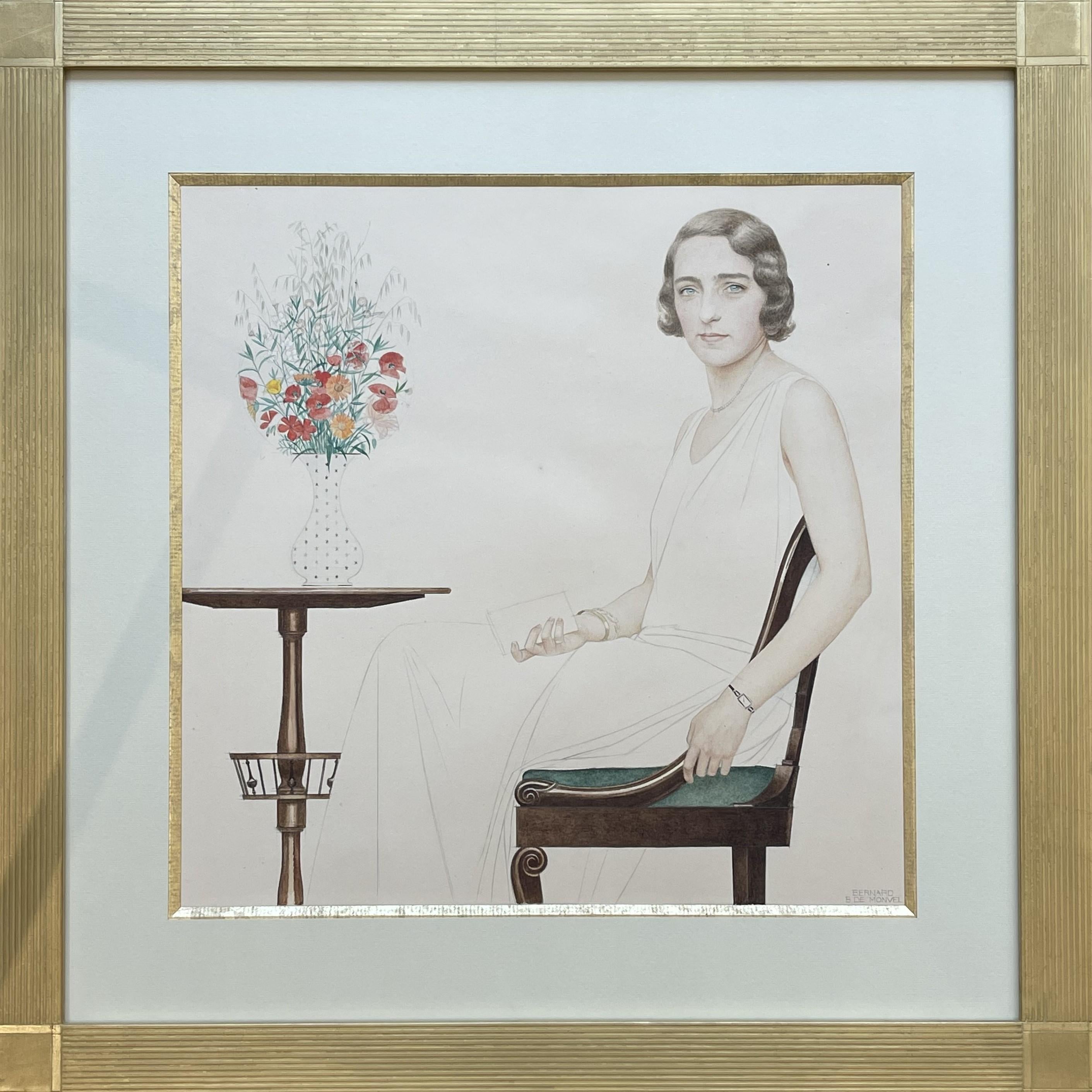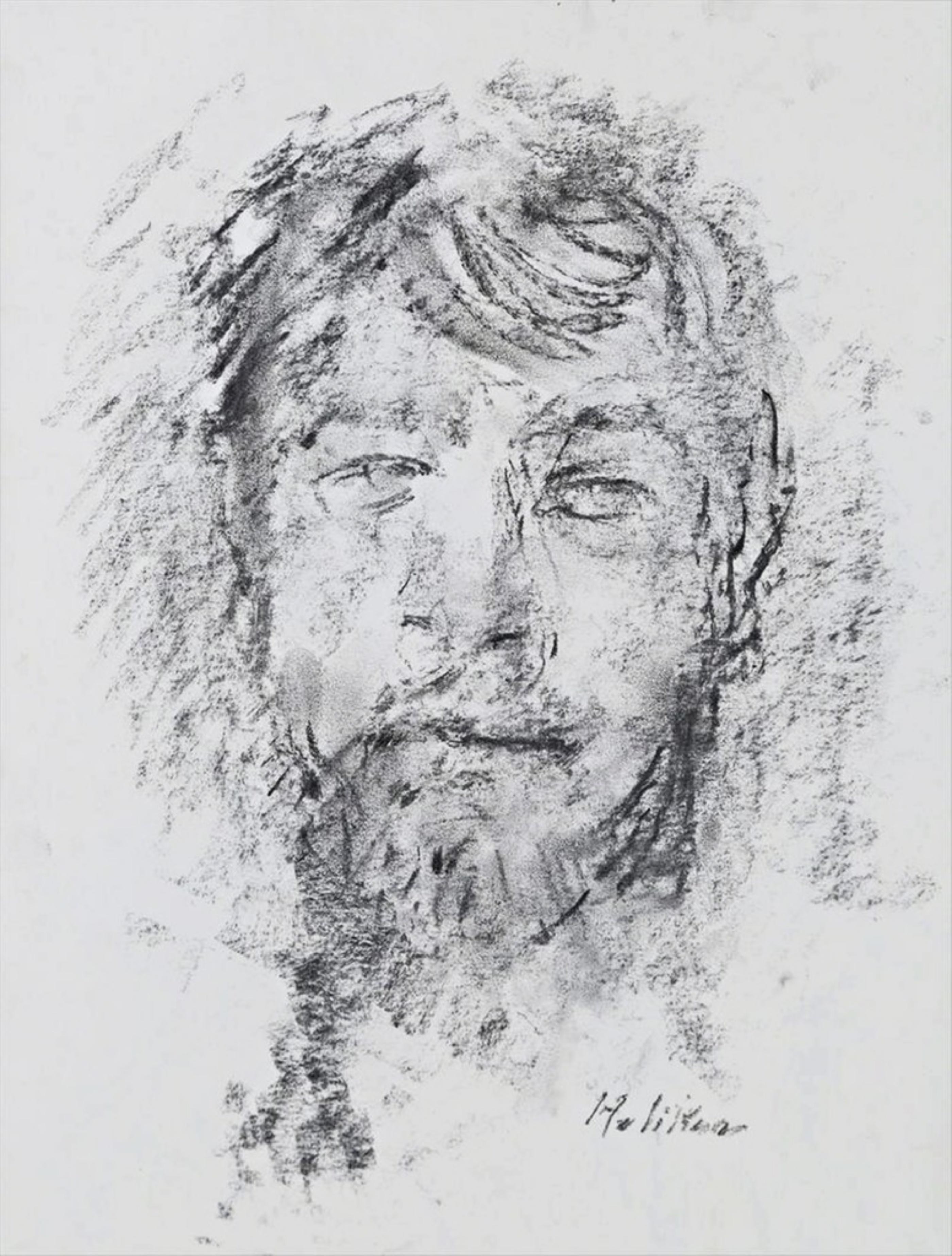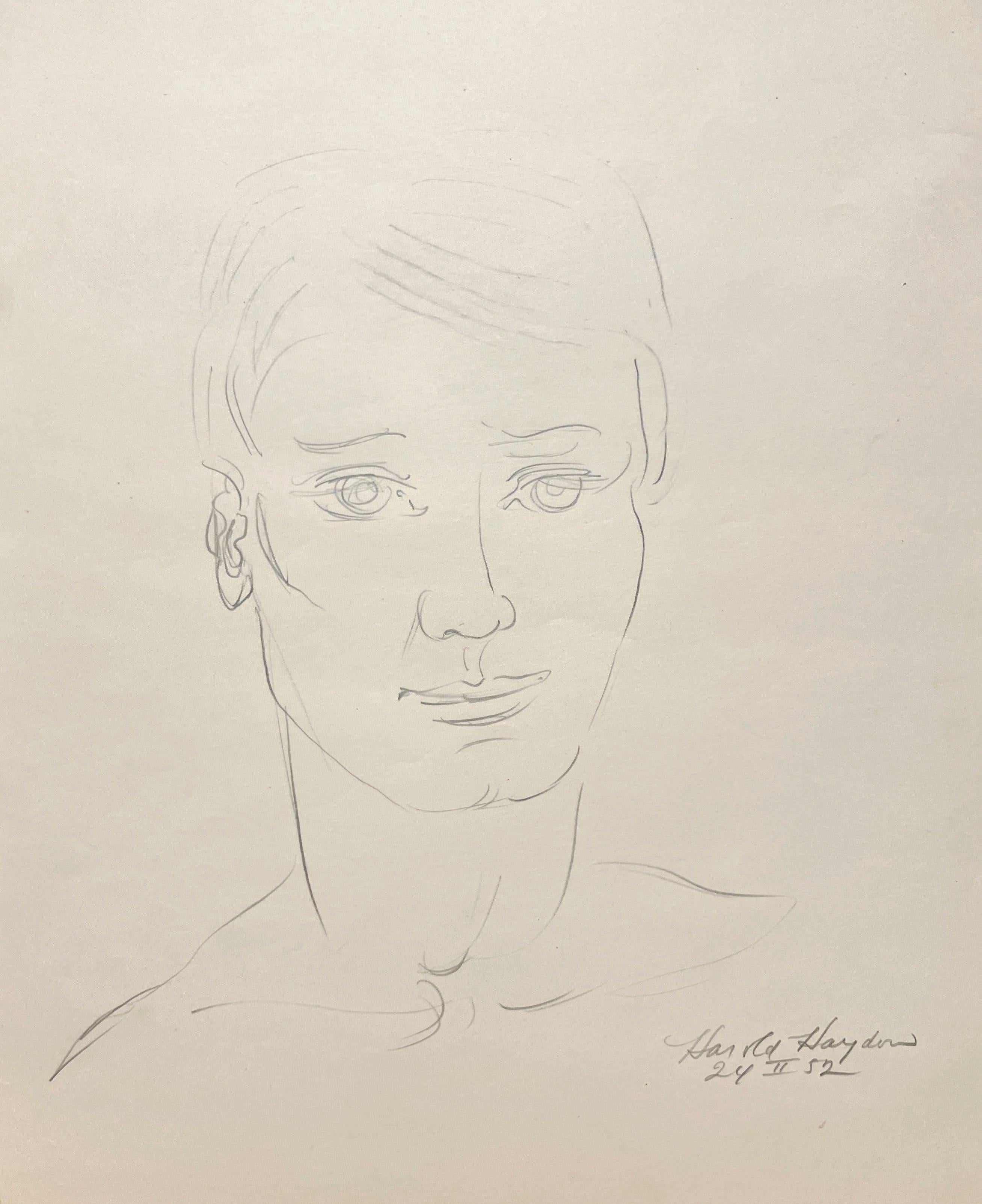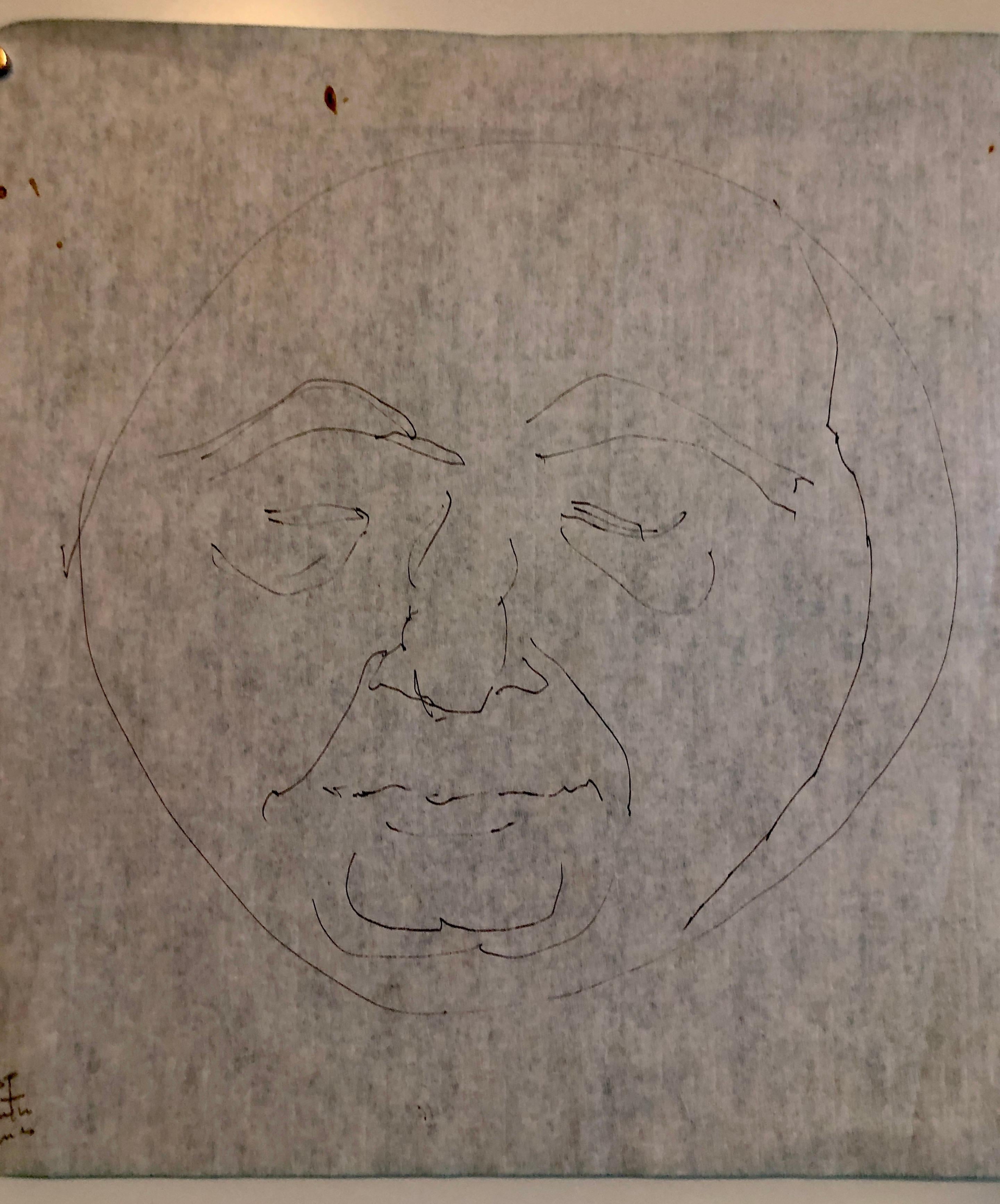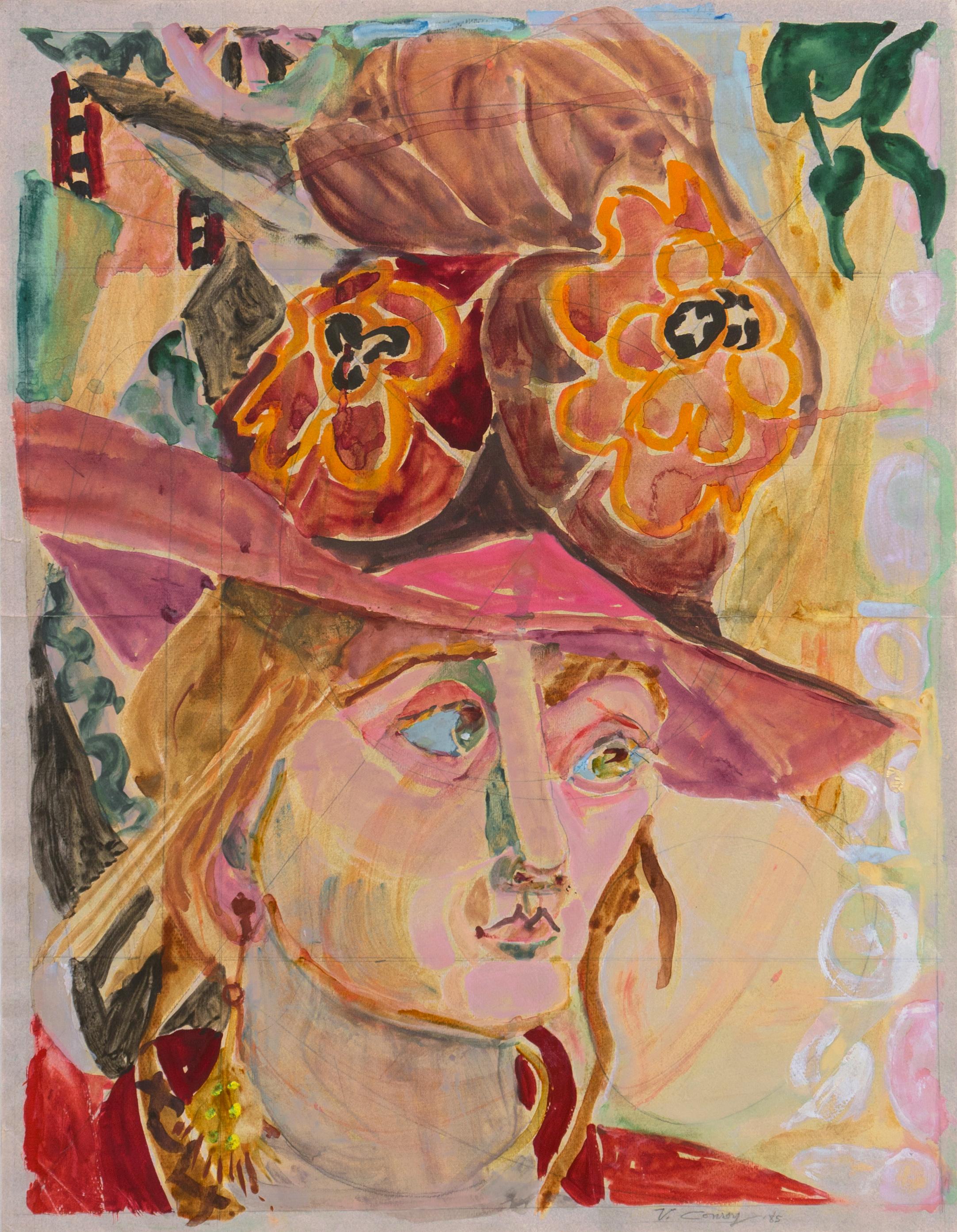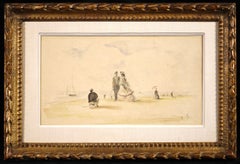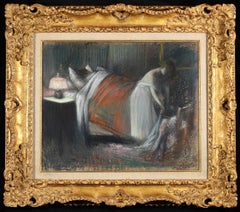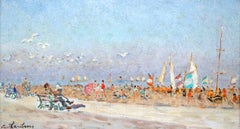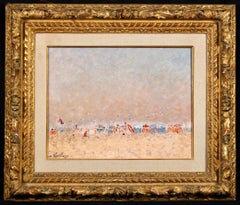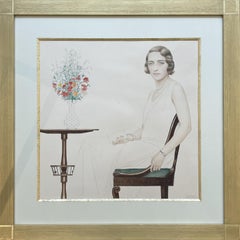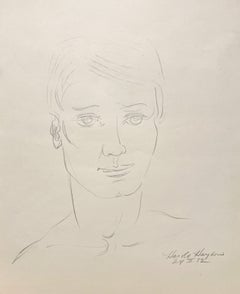Objekte ähnlich wie Portrait of Berthe Lipchitz - Modern Portrait Pencil Drawing - Amedeo Modigliani
Möchten Sie mehr Bilder oder Videos?
Zusätzliche Bilder oder Videos von dem*der Anbieter*in anfordern
1 von 14
Amedeo ModiglianiPortrait of Berthe Lipchitz - Modern Portrait Pencil Drawing - Amedeo Modigliani1916
1916
Angaben zum Objekt
Signed pencil on paper portrait drawing by Italian artist Amedeo Clemente Modigliani. The portrait is of Berthe Lipchitz who was the wife of Modigliani's friend, the sculptor Jacques Lipchitz. This work is a study for "Portrait of Jacques & Berthe Lipchitz" which hangs in the Art Institute of Chicago.
Signature:
Signed lower right
Dimensions:
Framed: 26.75"x18.25"
Unframed: 18.75"x12.25"
Provenance:
The collection of Leopold Survage
The collection of Dimitri Snegaroff
The collection of Leopold Zborowski
Galerie Charpentier - Paris 1958
Private french collection
Galerie Pierre Levy - Paris
Private collection - United Kingdom
Exhibited:
Galerie Charpentier - Cent Tableaux de Modigliani - Paris, 1958
Les Peintres de Zborowski - ~Foundation L'Hermitage, Lausanne 1994
Amedeo Modigliani Exhibition - Museo d'Arte Moderna, Lugano 1999
Amedeo Modigliani was born into a middle-class Jewish family and was the brother of Eugenio Modigliani, who later became the leader of the Italian socialist workers’ party prior to the rise of fascism. Modigliani suffered from poor health as a child and contracted pleurisy in 1895, followed in 1898 by typhus with pulmonary complications, which culminated in tuberculosis in 1901. He moved to Livorno to study under Guglielmo Micheli, who had himself been a pupil of Giovanni Fattori, one of the Macchiaioli group of painters who worked in strong colour patches (macchie) to achieve vivid light and colour effects; their approach came as a reaction against academic art in Italy and, in much the same way as the French Impressionists, they advocated painting from nature rather than aspiring to communicate any particular message or ideology. In 1902, Modigliani enrolled at the academy of fine arts in Florence. He travelled to Rome and Venice in 1903, where he devoted the bulk of his day to visiting museums. At around this time he started to read Dante, dreaming no doubt of the Vita Nuova; he also devoured the works of Leopardi, Carducci, d’Annunzio, Spinoza and Nietzsche.
In 1906, Modigliani moved to Paris, lodging at the Rue Caulaincourt. At that juncture, nothing about him appeared to presage the brilliant career that was to follow. His arrival in the artists’ quarter, then known colloquially as the maquis - the labyrinthine tangle of narrow streets around today’s Avenue Junot in Montmartre - went virtually unnoticed by the artists already living and working there, including Picasso, Braque and Derain. Modigliani’s painting made next to no immediate impact and he was recognised primarily on account of his frail constitution, flashing eyes, innate elegance and intellectual prowess. He was accepted in the community that was Montmartre but never belonged to any particular ‘set’ or circle, and there is no record of his ever having been invited to Pablo Picasso’s studio, the famous ‘wash house’.
The literate and highly articulate Modigliani opted instead for the companionship of Maurice Utrillo, an instinctual painter of whom it could charitably have been said that his conversation was, at best, limited. Nonetheless, Modigliani and ‘Litrillo’ (as Utrillo was commonly known to the street urchins - the ‘p’tits poulbots’) began to frequent the cabarets and dance halls of the Butte de Montmartre, and the nefarious hashish dens - post-Baudelaire ‘institutions’, frequented in the main by out-of-work writers and talentless artists. Modigliani developed an addiction, which, compounded by his alcoholism, took its toll. It also transformed him from an artist of limited ability into one devoid of bourgeois scruples.
In his monograph, Modigliani: Sa Vie et Son Oeuvre, written in 1926 shortly after Modigliani’s death, André Salmon hinted at a ‘pact with the devil’. While somewhat overstating the case, this rather unpromising painter from Livorno metamorphosed virtually overnight into an artist of rare ability and sensitivity. The turning-point came in 1907, when Modigliani met Paul Alexandre, a doctor who befriended him, took him under his wing and purchased some of his work. The banal paintings he had turned out in Montmartre were suddenly superseded by exceptional works, produced first in Montmartre ( Cellist, 1909), and then in Montparnasse.
In Montparnasse, Modigliani started to move in artistic circles, meeting Chaim Soutine, Marc Chagall, Jules Pascin and others, all of whom lived and worked in the building in the Rue Vaugirard known as ‘La Ruche’ (‘the beehive’). Then, in the Cité Falguière, he met the Romanian-born sculptor Constantin Brancusi, who encouraged him to take up sculpture, which he did, between 1909 and 1913. In 1914, several dealers, including the erstwhile poet Léopold Zborowski and the collector Paul Guillaume, tried with little success to market Modigliani’s paintings. From 1914 to 1916, Modigliani was caught up in a tempestuous affair with the English poet and journalist Beatrice Hastings. In 1917, however, he met Jeanne Hébuterne at the Colarossi Academy, who became his constant companion and model, and who gave birth to their daughter Jeanne in 1918. In 1918 and 1919, Modigliani and Jeanne spent time in Nice on the Côte d’Azur but by 1920 he was suffering from tubercular meningitis. His friends, Kisling and the Chilean Ortiz de Zarate, brought him and a pregnant Jeanne back to Paris, where he died on January 20 1920 in the Hôpital de la Charité. His last words were reputed to be: ‘Cara Italia’. Modigliani’s brother, by this time a socialist member of parliament, telegrammed instructions to ‘bury him as befits a prince’. Jeanne Hébuterne, a budding twenty-year-old painter, killed herself and her unborn child on the day of Modigliani’s funeral by jumping to her death from a fifth-floor window.
Modigliani’s first paintings were undistinguished portraits in the Impressionist manner. After moving to Paris in 1907, his early work was influenced by the Swiss-born lithographer Théophile Alexandre Steinlen, Henri de Toulouse-Lautrec and Pablo Picasso, the latter then in his ‘blue’ period. From the onset, Modigliani’s principal preoccupation was the human figure. After the artistic (and literal) limbo of Montmartre, when his output was confined to a few Expressionist-like paintings of street life, the theatre and the circus, Modigliani suddenly erupted on the scene in 1909 with Cellist, a robust, well-constructed and vividly coloured canvas that utterly exceeded all prior expectations. He had not taken part in the protracted debates that took place nightly in Picasso’s studio, but he had superficially assimilated the Cubist ideas developed by Picasso and Georges Braque. Above all, Modigliani had been influenced by African art, which was a key feature of the Cubist movement. He succeeded in treading a fine line between the coolly analytical Cubist approach and the all-too-common European perception of African art as a succession of exaggerated facial grimaces.
It would appear that Modigliani had always been attracted to sculpture as a discipline. The friendly encouragement he received as of 1909 from Brancusi no doubt intensified his interest and reinforced his attempts to achieve a sustained simplicity of line and form. In 1910, he befriended the Russian artists Alexander Archipenko and Jacques Lipchitz, both of whom recorded Modigliani’s distaste for modelling in clay (which he referred to as ‘mud’), on the grounds that it degraded the art of sculpture. Like Brancusi, Modigliani believed in working directly, carving from wood in the case of two extant pieces, and from (sand)stone in others, with the exception of a few bronzes which were, presumably, modelled in clay before being cast into bronze. His sculpture was influenced by archaic and non-western cultures - early Graeco-Roman, African and Khmer - as well as heads carved on columns adorning the façades of Romanesque and Gothic cathedrals (Modigliani rarely sculpted a rear view of his figures). Up to approximately 1912, his sculptures take the form of tall cylinders, usually with elongated heads and shallow relief indentations or projections to indicate the hairline, facial features and neck. He departed from this style only infrequently, most notably in a small number of pieces believed to have been sculpted in 1913, which are characterised by a compressed, cubistic format and shallower and less distinct features. Modigliani eventually abandoned sculpture, presumably because of his general health and circumstances, and possibly due to the fact that his sculptures sold for even less than his paintings. During the years that he devoted to sculpture, Modigliani is recorded as producing only thirty canvases, although after 1913 his sculpture became reflected in his painting.
Following his Montmartre days, Modigliani’s work developed in both quantitative and qualitative terms, presumably helped by the relative stability of his relationship with Jeanne Hébuterne. The first paintings after his short-lived sculptural phase saw him revert briefly to Neo-Impressionist pointillism, followed by a episode marked by Cubism, which was mainly evident in portraits of friends and fellow artists living and working in Montparnasse: Henri Laurens; Juan Gris (1915); Jacques Lipchitz and his Wife; Chaim Soutine; Léopold Sauvage; Paul Guillaume; Max Jacob; Béatrice Hastings con Capello (all 1916); Mlle Modigliani (1917); Léon Bakst; Léopold Zborowski; Concierge’s Son; Adolescent (1918); Mademoiselle Lunia Czechowska; Madame Zborowska; Portrait of the Artist’s Wife (1919). A large number of other portraits exist among his drawings, most of which were executed impromptu in the street or cafés. These quickly drawn portraits often exhibit an urgency and surprising lucidity. Examples include Portrait of the Gypsy Painter Fabiano de Castro; André Salmon (1918); Portrait of the Artist’s Wife (1919); and Lada, Author; Mario, Composer (1920).
Whatever his shortcomings, Amedeo Modigliani ranks as one of the 20th-century’s greatest painters of the female form. The bulk of his painted nudes were produced in 1915-1916 (prior to that date they were predominantly drawings), and are taken from every walk of life, such as a regular at a Montparnasse café, or a waitress at the soup kitchen where he ate his meagre meals. In each instance, he invested his models with an almost aristocratic hauteur. This is exemplified in a number of paintings (usually based on numerous prior drawings): Flower Girl; Blonde Lady; Sleeping Nude (1917); Blonde Nude; Young Woman; Maria (1918); Pink Nude; Reclining Nude; Nude on a Divan; Woman with a Fan (1919); and Young Woman in a Chemise; Reclining Nude (1920). Modigliani painted his subjects in elongated, elliptic ovals: the swell of a breast, the pronounced curve of the pelvis, the fullness of the thigh, the symmetrically oval face and the graceful arabesque of the body. Facial features are reduced to a bare minimum, with the eyes typically empty, like those of a statue. He employed colour as a constructive material in much the same way as stone in sculpture, juxtaposing muted pinks, ochres and pale browns against discreet background tones supplied by décor and garments. The overall effect is to yield a flat image devoid of chiaroscuro but which captures the essence of a subject. It has often been remarked that his women, with their elongated heads and long, graceful necks, generally tilted to one side, possess a melancholy beauty akin to that of the Siena Madonnas (reproductions of which Modigliani kept pinned on his studio wall), which accounts for Modigliani’s soubriquet as the ‘painter of sorrows’. From 1917, the majority of his nudes, characterised by a more pronounced elongation of the female body and lighter palette, were modelled by Jeanne Hébuterne and Luna Czechowska.
Very few artists have been the subject of so many monographs and biographies as Modigliani; the selection appended to this entry indicates only some of the more important of these. Too much, perhaps, has been made of his life as an artiste maudit, of his ‘accursed’ yet colourful life rather than the quality of his work. Some critics have detected in him an artist of great and persistent intellectual curiosity; others emphasise that he was a ‘gentleman to the end’ and stress his physical frailty, ignoring the fact that this was an integral component of his creativity. More seriously, his posthumous fame amongst the public at large acts both for and against him, as if his subsequent popularity has become a yardstick of his artistic ability. The mannerism of his style ensures that a ‘Modigliani’ is instantly recognisable, but his success in adapting Cubism and African art to a language and palette that are entirely his own places him squarely at the heart of the modern movement.
Amedeo Modigliani’s work has featured in numerous group exhibitions, including: Paris in 1908, when he showed his Jewess and three other canvases; the Salon des Indépendants in 1910; and the Salon d’Automne in 1912, where he exhibited examples of his sculpture. His posthumous inclusion in the 1922 Venice Biennale was regarded in Italy as a complete fiasco, prompting the critic Giovanni Scheiwiller to paraphrase Charles Baudelaire’s remark to the effect that, ‘we know that precious few will understand us, but that shall be sufficient’. In 1917-1918, the Berthe Weill Gallery organised a one-man show at the instigation of Zborowski but, on the order of the then chief of police, some of Modigliani’s sensual nudes were withdrawn on account of alleged indecency. On 20 December 1918, the Paul Guillaume Gallery exhibited several paintings by Modigliani alongside others by Matisse, Picasso and Derain.
All other exhibitions of Modigliani’s work have been held since his death. They include those at the Bernheim-Jeune Gallery in Paris (1922); Galerie Bing (Paris, 1925 and 1927); Marcel Benhelm Gallery (Paris, 1931); Palais des Beaux-Arts (Brussels, 1933); Kunsthalle Basel (1934); American-British Art Center (New York, 1944); Galerie de France (Paris, 1945 and 1949); Gimpels Fils Gallery (London, 1947); Cleveland Museum of Art (1951); Museum of Modern Art (New York, 1951); Cantini Museum (Marseilles, 1958); Palazzo Reale (Milan, 1958); Galerie Charpentier (Paris, 1958); Chicago Arts Club (1959); Cincinnati Art Museum (1959); Galleria Nazionale d’Arte Moderna (Rome, 1959); Boston Museum of Fine Arts (1961); Perls Galleries (New York, 1963 and 1966); Kyoto National Museum of Modern Art (1968); Musée Jacquemart-André (Paris, 1970); Musée St-Georges (Liège, 1980); Tokyo Arts Centre (1980); Musée de l’Art Moderne de la Ville de Paris (1970; a comprehensive exhibition of Modigliani’s sculptures); North Rhine-Westphalia Art Collection (Düsseldorf, 1991); Palazzo Grassi (Venice, 1993-1994); the Royal Academy (London, 1993-1994: an exhibition of 430 drawings from the collection of Paul Alexandre, subsequently repeated in Tokyo, Tel Aviv, Montreal and, in 1996, at the Musée des Beaux-Arts in Rouen); Modigliani: Angel with a Sombre Face ( Modigliani: l’ange au visage grave) at the Musée de Luxembourg (Paris, 2002); and Linear Grace: Drawing and Sculpture by Amedeo Modigliani, an exhibition mounted in 2003 by the University Art Museum and Gallery, Pokfulam, Hong Kong.
Museum and Gallery Holdings
Antwerp (Koninklijk Mus. voor Schone Kunsten): Crouching Nude
Buffalo (Albright-Knox AG): Servant Girl (La Servante) (c. 1918, oil on canvas); Two Women
Chicago (AI): Madame Pompadour (1915); Portrait of Jacques Lipchitz and his Wife (1916-1917); Woman with Necklace (1917)
Cincinnati (AM): Woman with a Red Necklace (painting); Portrait of Max Jacob (painting); Seated Nude (drawing); Caryatid (drawing); Untitled (engraving)
Cologne (Mus. Ludwig): Almaisa the Algerian (1917)
Copenhagen (Statens Mus. for Kunst): Self-portrait as Pierrot (1915); Alice (1916)
Detroit: Female Portrait
Düsseldorf (Kunstsammlung Nordrhein-Westfalen): Kisling (1915-1916); Portrait of Max Jacob (1916)
Helsinki (Ateneumin Taidemus.): Portrait of Léopold Survage (1917)
Indianapolis (MA): Boy in a Blue Jacket (1919)
London (Courtauld Institute of Art): Female nude (c. 1916, oil on canvas)
London (Tate Collection): Head (c. 1911-1912, limestone, sculpture); The Little Peasant (c. 1918, oil on canvas); Portrait of a Girl (c. 1917, oil on canvas)
Los Angeles (County MA): Frank Haviland (1914)
Merion (Barnes Foundation): Beatrice Hastings con Capello (1916); Reclining Nude (rear) (1917); Young Girl Seated (1918); Profile portrait of Jeanne Hébuterne (1918); Hanka Zborowska (1919); Cypress Trees and Houses (oil on canvas)
Milan (Gal. d’Arte Moderna): Portrait of Paul Guillaume (1915)
Moscow (Pushkin MFA): Female Portrait; Portrait of Blaise Cendrars (1919, drawing)
New York (Metropolitan Mus. of Art): Italian Woman; Jean Hébuterne in Camicia (1918); Reclining Nude (1918, oil on canvas)
New York (MoMA): Caryatid (c. 1913-1914, sculpture); Seated Nude (1914); Bride and Groom (1915); Hanka Zborowska (1917); Woman Leaning on Elbow (1918); Reclining Nude (Le Grand Nu) (1918-1919); Mario (1919-1920)
New York (Solomon R. Guggenheim Mus.): Head (c. 1912, sculpture); Reclining Nude with Hands behind Head (1917); Student (1917); Boy in Blue (1918); Portrait of Jeanne Hébuterne in front of a Chest of Drawers (1919); Yellow Sweater (1919)
Paris (MAMVP): Blue-Eyed Woman; Woman with Earrings: Lunia Czechowska with a Fan (1919)
Paris (MNAM-CCI): Head or Caryatid (1913, sculpture); Lolotte (1917); Portrait of Madame Haydn (c. 1917)
Paris (Mus. de l’Orangerie): Red-Haired Girl (1915); Antonia (1915); Woman with a Velvet Ribbon (1915); Portrait of Paul Guillaume (1915); Young Apprentice (1917-1918)
Paris (Mus. National des Arts et Traditions Populaires): Portrait of a Young Woman with Long Hair (1910-1912)
Riehen (Fondation Beyeler): Portrait of Beatrice Hastings (1916)
Rome (Gal. Nazionale d’Arte Moderna): Woman with a Necklace (Madame Zborowska) (1917)
São Paulo (MA): Diego Rivera (1914-1915); Portrait of Léopold Zborowski (1917); Renée (1917); Portrait of Madame G. Van Muyden (1917)
Troyes (MAM, Pierre and Denise Lévy donation): Female Head
Washington DC (NGA): Head of a Woman (1910-1911, limestone, sculpture); Chaim Soutine (1917, oil on canvas); Gypsy Woman with Baby (1919, oil on canvas); other paintings
Zurich (Kunsthaus): Servant Girl (1916
- Schöpfer*in:Amedeo Modigliani (1884 - 1920, Italienisch)
- Entstehungsjahr:1916
- Maße:Höhe: 67,95 cm (26,75 in)Breite: 46,36 cm (18,25 in)
- Medium:
- Bewegung und Stil:
- Zeitalter:
- Zustand:Very good original condition.
- Galeriestandort:Marlow, GB
- Referenznummer:Anbieter*in: LFA04521stDibs: LU415316436162
Anbieterinformationen
5,0
Platin-Anbieter*in
Premium-Anbieter*innen mit einer Bewertung über 4,7 und 24 Stunden Reaktionszeit
Gründungsjahr 2001
1stDibs-Anbieter*in seit 2016
704 Verkäufe auf 1stDibs
Typische Antwortzeit: 2 Stunde
- VersandAngebot wird abgerufen …Versand von: Marlow, Vereinigtes Königreich
- Rückgabebedingungen
Einige Inhalte dieser Seite wurden automatisch übersetzt. Daher kann 1stDibs nicht die Richtigkeit der Übersetzungen garantieren. Englisch ist die Standardsprache dieser Website.
Authentizitätsgarantie
Im unwahrscheinlichen Fall eines Problems mit der Echtheit eines Objekts kontaktieren Sie uns bitte innerhalb von 1 Jahr für eine volle Rückerstattung. DetailsGeld-Zurück-Garantie
Wenn Ihr Objekt nicht der Beschreibung entspricht, beim Transport beschädigt wurde oder nicht ankommt, kontaktieren Sie uns bitte innerhalb von 7 Tagen für eine vollständige Rückerstattung. DetailsStornierung innerhalb von 24 Stunden
Sie können Ihren Kauf jederzeit innerhalb von 24 Stunden stornieren, ohne jegliche Gründe dafür angeben zu müssen.Geprüfte Anbieter*innen
Unsere Anbieter*innen unterliegen strengen Dienstleistungs- und Qualitätsstandards, wodurch wir die Seriosität unserer Angebote gewährleisten können.Preisgarantie
Wenn Sie feststellen, dass ein*e Anbieter*in dasselbe Objekt anderswo zu einem niedrigeren Preis anbietet, werden wir den Preis entsprechend anpassen.Zuverlässige weltweite Lieferung
Unsere erstklassigen Versandunternehmen bieten spezielle Versandoptionen weltweit, einschließlich individueller Lieferung.Mehr von diesem*dieser Anbieter*in
Alle anzeigenSur la plage de Deauville - Impressionistisches figuratives Aquarell von Eugene Boudin
Von Eugène Louis Boudin
Signiertes Aquarell auf Papier Landschaft um 1865 von Französisch impressionistischen Maler Eugene Boudin. Dieses Werk zeigt einen Künstler, der ein Porträt eines eleganten Paares am...
Kategorie
1860er, Impressionismus, Figurative Zeichnungen und Aquarelle
Materialien
Papier, Wasserfarbe
Le Lever – Impressionistische Figuren in Innenraumpastell von Jean Louis Forain
Von Jean Louis Forain
Signiertes impressionistisches figuratives Pastell auf Karton um 1895 von dem gesuchten französischen impressionistischen Maler Jean Louis Forain. Das Stück zeigt einen Mann, der in ...
Kategorie
Spätes 19. Jahrhundert, Impressionismus, Figurative Gemälde
Materialien
Pastell, Karton
Beau Temps en Aout - Deauville - Moderne Landschaft Ölgemälde von André Hambourg
Von André Hambourg
Signierte Figuren in Landschaft Öl auf Leinwand circa 1980 von Französisch modernistischen Maler Andre Hambourg. Dieses wunderschöne Werk zeigt Familien, die im Hochsommer einen Tag ...
Kategorie
1980er, Moderne, Figurative Gemälde
Materialien
Leinwand, Öl
Beauchamps Chaud a Trouville - Moderne Landschaft Ölgemälde von André Hambourg
Von André Hambourg
Signierte Figuren in einer Landschaft in Öl auf Leinwand um 1980 von dem französischen modernistischen Maler Andre Hambourg. Dieses schöne Werk zeigt Familien, die einen Tag am Meer ...
Kategorie
1980er, Moderne, Figurative Gemälde
Materialien
Leinwand, Öl
Nu assis sur une chaise, Modernistisches Ölgemälde, Akt in Inneneinrichtung von Maurice Brianchon
Von Maurice Brianchon
Wunderschönes Öl auf Leinwand von Maurice Brianchon, einem französischen Maler der Moderne, um 1960. Das Werk zeigt einen blonden Akt, der auf einem dem Künstler abgewandten Holzstuh...
Kategorie
Mitte des 20. Jahrhunderts, Moderne, Aktgemälde
Materialien
Leinwand, Öl
Le Bal de Moulin Rouge – Modernistisches figuratives Ölgemälde von Marcel Francois Leprin
Von Marcel François Leprin
Signiert, betitelt und datiert 1921 Figuren im Inneren Öl auf Leinwand von Modernist Maler Marcel Francois Leprin. Dieses wunderbare Stück zeigt einen Ball im Moulin Rouge, einem Kab...
Kategorie
1920er, Moderne, Figurative Gemälde
Materialien
Leinwand, Öl
Das könnte Ihnen auch gefallen
Bernard BOUTET DE MONVEL (1881 - 1949), „Porträt von Miss Lise Brissaud“
Bernard Boutet de Monvel war ein französischer Maler, Bildhauer, Graveur, Modezeichner und Innenarchitekt. Obwohl er zunächst für seine Radierungen bekannt war, erlangte er auch durc...
Kategorie
1920er, Moderne, Porträtzeichnungen und - aquarelle
Materialien
Papier, Wasserfarbe, Bleistift
Moderne französische Zeichnung von Jean Hélion - Veil Homme
Von Jean Hélion
Schleier Homme
1947
Zeichnung
26,9 x 21 x 0,1 cm
Eingetragen im Werkverzeichnis unter der Inventarnummer: N°0252 Kat. B
ohne Rahmen verkauft
über Jean Hélion (21. April 1904 - 27. O...
Kategorie
1960er, Moderne, Figurative Zeichnungen und Aquarelle
Materialien
Papier, Bleistift
Self-Portrait (original signierte, einzigartige Kohlezeichnung) Label der Galerie Kraushaar
Von John Heliker
John Heliker
Self-Portrait, 1991
Kohlestift auf Papier (mit originalem Label der Galerien Kraushaar verso)
Auf der Vorderseite signiert
trägt verso auf dem Rahmen das originale Label...
Kategorie
Ende des 20. Jahrhunderts, Moderne, Porträtzeichnungen und - aquarelle
Materialien
Papier, Holzkohle, Kohlestift
Ein sensibles Porträt eines jungen Mannes aus der Mitte der 1950er Jahre von Harold Haydon
Von Harold Haydon
Ein sensibles, fein gezeichnetes Porträt eines jungen Mannes aus der Mitte der 1950er Jahre von Harold Haydon (1909-1994), einem bekannten Künstler aus Chicago. Größe des Kunstwerks...
Kategorie
Mitte des 20. Jahrhunderts, Amerikanische Moderne, Porträtzeichnungen un...
Materialien
Papier, Grafit
Bostoner abstrakt-expressionistischer Hyman Bloom, Original-Bleistiftzeichnung Martin Sumers
Von Hyman Bloom
Dies ist ein einzigartiges Kunstwerk. Dies ist eine Originalzeichnung von Hyman Bloom von seinem Künstlerkollegen und sehr guten Freund Martin Sumers. Ich glaube, dies wurde bei den ...
Kategorie
20. Jahrhundert, Moderne, Figurative Zeichnungen und Aquarelle
Materialien
Papier, Bleistift
„Oleta's Hat“, Ausstellung der Carmel Art Association, kalifornische Künstlerin, SFMA
Signiert unten rechts "V. Conroy" für Virginia Conroy (Amerikanerin, 1922-2006) und datiert 1985.
Ausgestellt: Carmel Art Association, 1983 (auf Originalunterlage).
Diese frühe kal...
Kategorie
1980er, Moderne, Porträtzeichnungen und - aquarelle
Materialien
Papier, Wasserfarbe, Gouache, Grafit
